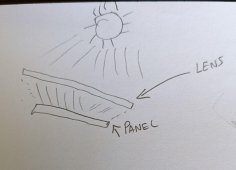jetjaguar
New Member
Sorry in advance if this is bad science.
I had a thought today as I was trying to figure out ways to get more "free energy". See picture.
What about the idea of mounting a sort of diffuse fresnel-type lens in front of a solar panel to increase the "surface area" of the sun's rays that get directed to the panels? Sort of like panel glasses or something.
You wouldn't want the lens to strongly focus and heat the panels, just redirect the "edges" to the panels. You wouldn't even need a full lens, just a ring around the panels. Is this crazy thinking? Anyone tried this?
I had a thought today as I was trying to figure out ways to get more "free energy". See picture.
What about the idea of mounting a sort of diffuse fresnel-type lens in front of a solar panel to increase the "surface area" of the sun's rays that get directed to the panels? Sort of like panel glasses or something.
You wouldn't want the lens to strongly focus and heat the panels, just redirect the "edges" to the panels. You wouldn't even need a full lens, just a ring around the panels. Is this crazy thinking? Anyone tried this?



